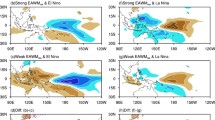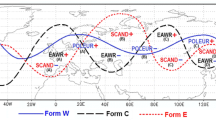Abstract
This study investigates the individual effects of the East Atlantic/West Russia (EATL/WRUS) and Western Pacific (WP) teleconnection patterns and their combined effect on the East Asian winter monsoon (EAWM). The contributions of the respective EATL/WRUS and WP teleconnection patterns to the EAWM are revealed by removing the dependence on the Arctic Oscillation (AO) and the El Niño-Southern Oscillation (ENSO) using a linear regression, which are named as N_EATL/WRUS and N_WP, respectively. This is because the EATL/WRUS (WP) is closely linked to the Arctic (tropics) region. A significant increase (decrease) in temperature over East Asia (EA) corresponding to a weak (strong) EAWM is associated with the N_EATL/WRUS and N_WP teleconnection patterns during the positive (negative) phases. In order to examine impacts of these two teleconnections on the EAWM, three types of effects are reconstructed on the basis of ± 0.5 standard deviation: 1) Combined effect, 2) N_EATL/WRUS effect, and 3) N_WP effect. The positive N_EATL/WRUS teleconnection induces to a weakened Siberian High and a shallow EA trough at the mid-troposphere through wave propagation, leading to the weak EAWM. During the positive N_WP pattern, warm air from the tropics flows toward the EA along western flank of an anomalous anticyclone over the North Pacific that is relevant to the meridional shift of the Aleutian Low. When the two mid-latitude teleconnections have the in-phase combination, the increase in temperature over EA appears to be more pronounced than the individual effects by transporting warm air from tropics via strong southeasterly wind anomalies induced by anomalous zonal pressure gradient between the Siberian High and Aleutian Low. Therefore, the impact of the mid-latitude teleconnections on the EAWM becomes robust and linearly superimposed, unlike a nonlinear in-phase combined effect of the AO and ENSO.
Similar content being viewed by others
References
Alexander, M. A., D. J. Vimont, P. Chang, and J. D. Scott, 2010: The impact of extratropical atmospheric variability on ENSO: Testing the seasonal footprinting mechanism using coupled model experiments. J. Climate, 23, 2885–2901, doi:10.1175/2010JCLI3205.1.
Barnston, A. G., and R. E. Livezey, 1987: Classification, seasonality and persistence of low-frequency atmospheric circulation pattern. Mon. Wea. Rev., 115, 1093–1126, doi:10.1175/1520-0493(1987)115<1083: CSAPOL>2.0.CO;2.
Chen, W., H.-F. Graf, and R.-H. Huang, 2000: The interannual variability of East Asian winter monsoon and its relation to the summer monsoon. Adv. Atmos. Sci., 17, 48–60, doi:10.1007/s00376-000-0042-5.
Chen, W., J. Feng, and R. Wu, 2013a: Roles of ENSO and PDO in the link of the East Asian winter monsoon to the following summer monsoon. J. Climate, 26, 622–635, doi:10.1175/JCLI-D-12-00021.1.
Chen, W., X. Q. Lan, L. Wang, and Y. Ma, 2013b: The combined effects of the ENSO and the Arctic Oscillation on the winter climate anomalies in East Asia. Chinese Sci. Bull., 58, 1355–1362, doi:10.1007/s11434-012-5654-5.
Chu, J.-E., N. H. Saji, K.-J. Ha, 2012: Nonlinear, intraseasonal phases of the East Asian summer monsoon: Extraction and analysis using selforganizing maps. J. Climate, 25, 6975–6988, doi:10.1175/JCLI-D-11-00512.1.
Cheung, H. N., W. Zhou, H. Y. Mok, and M. C. Wu, 2012: Relationship between Ural-Siberian blocking and the East Asian winter monsoon in relation to the Arctic Oscillation and the El Niño-Southern Oscillation. J. Climate, 25, 4242–4257, doi:10.1175/JCLI-D-11-00225.1.
Gong, D.-Y., and C.-H. Ho, 2002: The Siberian high and climate change over middle to high latitude Asia. Theor. Appl. Climatol., 72, 1–9, doi: 10.1007/s007040200008.
Ha, K.-J., K.-Y. Heo, S.-S. Lee, K.-S. Yun, and J.-G. Jhun, 2012: Variability in the East Asian monsoon: A review. Meteor. Appl., 19, 200–215, doi:10.1002/met.1320.
He, S., and H. Wang, 2013: Oscillating Relationship between the East Asian winter monsoon and ENSO. J. Climate., 26, 9819–9838, doi: 10.1175/JCLI-D-13-00174.1.
Horel, J. D., and J. M. Wallace, 1981: Planetary-scale atmospheric phenomena associated with the Southern Oscillation. Mon. Wea. Rev., 109, 813–829, doi:10.1175/1520-0493(1981)109<0813:PSAPAW>2.0.CO;2.
Jhun, J.-G., and E.-J. Lee, 2004: A new East Asian winter monsoon index and associated characteristics of winter monsoon. J. Climate, 17, 711–726, doi:10.1175/1520-0442(2004)017<0711:ANEAWM>2.0.CO;2.
Kalnay, E., and Coauthors, 1996: The NCEP/NCAR 40-year reanalysis project. Bull. Amer. Meteor. Soc., 77, 437–471, doi:10.1175/1520-0477(1996)077<0437:TNYRP>2.0.CO;2.
Kanamitsu, M., W. Ebisuzaki, J. Woollen, S.-K. Yang, J. J. Hnilo, M. Fiorino, and G. L. Potter, 2002: NCEP-DOE AMIP-II reanalysis (R-2). Bull. Amer. Meteor. Soc., 83, 1631–1643, doi:10.1175/BAMS-83-11-1631.
Kim, J.-W., S.-W. Yeh, and E.-C. Chang, 2014: Combined effect of El Nino-Southern oscillation and Pacific decadal oscillation on the East Asian winter monsoon. Climate Dyn., 42, 957–971, doi:10.1007/s00382-013-1730-z.
Kim, Y., K.-Y. Kim, and J.-G. Jhun, 2013: Seasonal evolution mechanism of the East Asian winter monsoon and its interannual variability. Climate Dyn., 41, 1213–1228, doi:10.1007/s00382-012-1491-0.
Lee, J.-Y., S.-S. Lee, B. Wang, K.-J. Ha, and J.-G. Jhun, 2013a: Seasonal prediction and predictability of the Asian winter temperature variability. Climate Dyn., 41, 573–587, doi:10.1007/s00382-012-1588-5.
Lee, S.-S., S.-H. Kim, J.-G. Jhun, K.-J. Ha, and Y.-W. Seo, 2013b: Robust warming over East Asia during the boreal winter monsoon and its possible causes. Environ. Res. Lett., 8, 034001, doi:10.1088/1748-9326/8/3/034001.
Li, F., H. J. Wang, and Y. Q. Gao, 2014: On the strengthened relationship between East Asian winter monsoon and Arctic oscillation: A comparison of 1950-1970 and 1983-2012. J. Climate, 27, 5075–5091, doi:10.1175/JCLI-13-00335.1.
Li, Y., and S. Yang, 2010: A dynamical index for the East Asian winter monsoon. J. Climate, 23, 4255–4262, doi:10.1175/2010JCLI3375.1.
Lim, Y.-K., and H.-D. Kim, 2013: Impact of the dominant large-scale teleconnections on winter temperature variability over East Asia. J. Geophys. Res., 118, 7835–7848, doi:10.1002/jgrd.50462.
Lim, Y.-K., 2015: The East Atlantic/West Russia (EA/WR) teleconnection in the North Atlantic: Climate impact and relation to Rossby wave propagation. Climate Dyn., 44, 3211–3222, doi:10.1007/s00382-014-2381-4.
Lim, Y.-K., and H.-D. Kim, 2016: Comparison of the impact of the Arctic oscillation and Eurasian teleconnection on interannual variation in East Asian winter temperatures and monsoon. Theor. Appl. Climatol., 124, 267–179, doi:10.1007/s00704-015-1418-x.
Linkin, M. E., and S. Nigam, 2008: The North Pacific oscillation-West Pacific teleconnection pattern: Mature-phase structure and winter impacts. J. Climate, 21, 1979–1997, doi:10.1175/2007JCLI2048.1.
Liu, Y. Y., L. Wang, W. Zhou, and W. Chen, 2014: Three Eurasian teleconnection patterns: Spatial structures, temporal variability, and associated winter climate anomalies. Climate Dyn., 42, 2817–2839, doi:10.1007/s00382-014-2163-z.
Luo, X., and, Y. A. Zhang, 2015: The linkage between upper-level jet streams over East Asia and East Asian winter monsoon variability. J. Climate, 28, 9013–9028, doi:10.1175/JCLI-D-15-0160.1.
Park, H.-J., and J.-B. Ahn, 2016: Combined effect of the Arctic oscillation and the Western Pacific pattern on East Asia winter temperature. Climate Dyn., 46, 3205–3221, doi:10.1007/s00382-015-2763-2.
Park, T.-W., C.-H. Ho, and S. Yang, 2011: Relationship between the Arctic oscillation and cold surges over East Asia. J. Climate, 24, 68–83, doi:10.1175/2010JCLI3529.1.
Takaya, K., and H. Nakamura, 2013: Interannual variability of the East Asian winter monsoon and associated modulations of the planetary waves. J. Climate, 26, 9445–9461, doi:10.1175/JCLI-D-12-00842.1.
Thompson, D. W. J., and J. M. Wallace, 1998: The Arctic oscillation signature in the wintertime geopotential height and temperature fields. Geophys. Res. Lett., 25, 1297–1300. doi:10.1029/98GL00950.
Thompson, D. W. J., and J. M. Wallace, 2000: Annular modes in the extratropical circulation. Part I: Month-to-month variability. J. Climate, 13, 1000–1016, doi: 10.1175/1520-0442(2000)013<1000:AMITEC>2.0.CO;2.
Uppala, S. M., and Coauthors, 2005: The ERA-40 re-analysis. Quart. J. Roy. Meteor. Soc., 131, 2961–3012, doi:10.1256/qj.04.176.
Wallace, J. M., and D. S. Gutzler, 1981: Teleconnections in the geopotential height field during the Northern Hemisphere winter. Mon. Wea. Rev., 109, 784–812, doi:10.1175/1520-0493(1981)109<0784: TITGHF>2.0.CO;2.
Wang, B., R. Wu, and X. Fu, 2000: Pacific-East Asian teleconnection: How does ENSO affect East Asian climate? J. Climate, 13, 1517–1536, doi:10.1175/1520-0442(2000)013<1517:PEATHD>2.0.CO;2.
Wang, B., Z. Wu, C.-P. Chang, J. Liu, J. Li, and T. Zhou, 2010: Another look at interannual-to-interdecadal variations of the East Asian winter monsoon: The Northern and Southern temperature modes. J. Climate, 23, 1495–1512, doi:10.1175/2009JCLI3243.1.
Wang, H., S. He, and J. Liu, 2013: Present and future relationship between the East Asian winter monsoon and ENSO: Results of CMIP5. J. Geophys. Res., 118, 5222–5237, doi:10.1002/jgrc.20332.
Wang, L., and W. Chen, 2014: An intensity index for the East Asian winter monsoon. J. Climate, 27, 2361–2374, doi:10.1175/JCLI-D-13-00086.1.
Wang, L., W. Chen, and R. H. Huang, 2008: Interdecadal modulation of PDO on the impact of ENSO on the East Asian winter monsoon. Geophys. Res. Lett., 35, L20702, doi:10.1029/2008GL035287.
Wang, L., R. Huang, L. Gu, W. Chen, and L. Kang, 2009a: Interdecadal variations of the East Asian winter monsoon and their association with quasi-stationary planetary wave activity. J. Climate, 22, 4860–4872, doi:10.1175/2009JCLI2973.1.
Wang, L., W. Chen, W. Zhou, and R. H. Huang, 2009b: Interannual variations of East Asian trough axis at 500 hPa and its association with the East Asian winter monsoon pathway. J. Climate, 22, 600–614, doi:10.1175/2008JCLI2295.1.
Wang, N., and Y. Zhang, 2015: Evolution of Eurasian teleconnection pattern and its relationship to climate anomalies in China. Climate Dyn., 44, 1017–1028, doi:10.1007/s00382-014-2171-z.
Wang, X., C. Wang, W. Zhou, D. Wang, and J. Song, 2011: Teleconnected influence of North Atlantic sea surface temperature on the El Niño onset. Climate Dyn., 37, 663–676, doi:10.1007/s00382-010-0833-z.
Wei, K., Z. Cai, W. Chen, and L. Xu, 2016: The effect of a well-resolved stratosphere on East Asian winter climate. Climate Dyn., doi:10.1007/s00382-016-3419-6.
Wu, B., and J. Wang, 2002: Winter Arctic oscillation, Siberian high and East Asian winter monsoon. Geophys. Res. Lett., 29, 1897, doi:10.1029/2002GL015373.
Wu, B., R. Zhang, and R. D’Arrigo, 2006: Distinct modes of the East Asian winter monsoon. Mon. Wea. Rev., 134, 2165–2179, doi:10.1175/MWR3150.1.
Wu, R., W. Chen, G. Wang, and K. Hu, 2014: Relative contribution of ENSO and East Asian winter monsoon to the South China Sea SST anomalies during ENSO decaying years. J. Geophys. Res. Atmos., 119, 5046–5064, doi:10.1002/2013JD021095.
Yang, L. N., and B. Y. Wu, 2013: Interdecadal variations of the East Asian winter surface air temperature and possible causes. Chinese Sci. Bull., 58, 3969–3977, doi:10.1007/s11434-013-5911-2.
Yang, S., K. M. Lau, and K. M. Kim, 2002: Variations of the East Asian jet stream and Asian-Pacific-American winter climate anomalies. J. Climate, 15, 306–325, doi:10.1175/1520-0442(2002)015<0306:VOTEAJ> 2.0.CO;2.
Yun, K.-S., S.-H. Shin, K.-J. Ha, A. Kitoh, and S. Kusunoki, 2008: East Asian Precipitation Change in the Global Warming Climate Simulated by a 20-km Mesh AGCM, Asia-Pac. J. Atmos. Sci., 44, 233–247.
Yun, K.-S., Y.-W. Seo, K.-J. Ha, J.-Y. Lee, and Y. Kajikawa, 2014: Interdecadal changes in the Asian winter monsoon variability and its relationship with ENSO and AO. Asia-Pac. J. Atmos. Sci., 50, 531–540, doi:10.1007/s13143-014-0042-5.
Zhou, L.-T., and R. Wu, 2010: Respective impacts of the East Asian winter monsoon and ENSO on winter rainfall in China. J. Geophys. Res., 115, D02107, doi:10.1029/2009JD012502.
Author information
Authors and Affiliations
Corresponding author
Rights and permissions
About this article
Cite this article
Oh, H., Jhun, JG., Ha, KJ. et al. Combined effect of the East Atlantic/West Russia and Western Pacific teleconnections on the East Asian winter monsoon. Asia-Pacific J Atmos Sci 53, 273–285 (2017). https://doi.org/10.1007/s13143-017-0030-7
Received:
Accepted:
Published:
Issue Date:
DOI: https://doi.org/10.1007/s13143-017-0030-7




